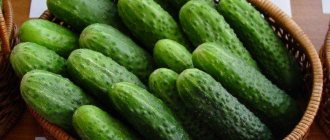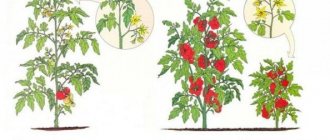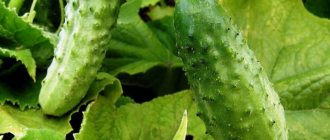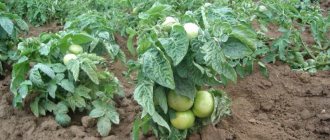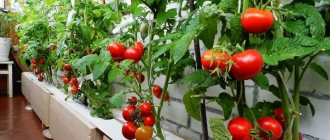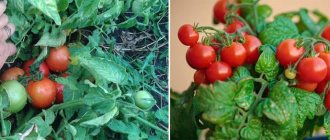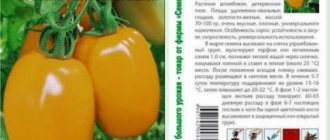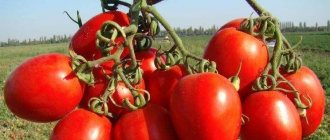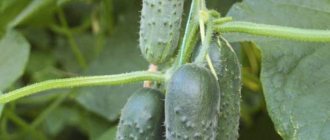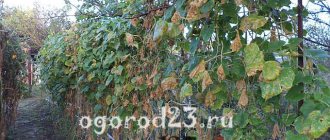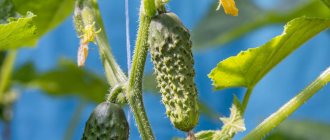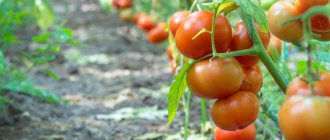The changeable climate of the Moscow region dictates its own rules for gardeners and farmers. Fortunately, the conditions allow for a rich and stable harvest. But you need to immediately choose the right resistant species. We are sharing a catalog of the best varieties of cucumbers for the Moscow region with photos, names and descriptions!
The highest-yielding varieties of cucumbers for the Moscow region
Fruitful varieties of cucumbers allow you to collect up to 16 kg of fruit from one square, and even more. Very tempting!
Summer resident
The early hybrid can be grown in open ground or in greenhouses. It is tall and unpretentious, but needs pollination by bees. You can plant it in May, when there is definitely no frost.
Amur
The ultra-early hybrid is perfectly adapted to the conditions of the middle zone. It begins to bear fruit approximately 37-40 days after full germination.
White Night
A productive hybrid produces dark green cucumbers of medium size, up to 9 cm. The surface of the fruit is distinctly lumpy, and the flesh is dense, but very tasty.
Corinto
This very productive cucumber variety reaches its maximum potential in greenhouses. The plant is quite powerful, producing large cylindrical fruits up to 22 cm long.
Hercules
The salad variety produces large fruits up to 17 cm and weighing up to 170 g. It is valued not only for its yield, but also for its excellent commercial qualities, and also for its resistance to mosaic and spotting.
Nezhinsky
Bee-pollinated mid-late varietal crop. Nezhinsky was bred by breeders in the Moscow region and zoned for all regions. It can be successfully grown both in greenhouse conditions (which is preferable for the northern regions or for the winter-spring period) and in a standard sunny area.
| Originator and year of inclusion in the register | Agrofirm Search LLC, Moscow region, 2009 |
| Recommended growing method | Open ground/greenhouses |
| Dates of fruiting | 50-65 day |
| The need for pollinators | Yes |
| Weight | 80-110 g |
| Length | 9-12 cm |
| Productivity | 5 kg/1 m2 |
| Application | Universal |
| Peculiarities | Spot resistance |
The plant is vigorous, highly branched, with medium-sized leaves. Its loops can reach 2 meters or more. Zelentsy are formed in an elongated ovoid shape, dark green, with small light stripes. There are large tubercles on the surface.
Related article:
Competent planning of vegetable neighborhood
Nezhinsky is considered one of the best varieties of cucumbers for canning and pickling. Its flesh is tender and crispy, with a pleasant fresh taste and aroma. There is no bitterness.
Early varieties of cucumbers for the Moscow region
Early varieties are good because they ripen very quickly. On average, it takes about 45 days, although there are real record holders who do it in 39-40 days.
Altai early
The variety is adapted even to the Northern regions, so it feels great in open ground in the Moscow region. Finely tuberous fruits of a neat oval shape grow up to 10 cm.
Vyaznikovsky
A very early and productive variety with bright light green fruits of an elongated shape. Gradually the cucumbers darken. They are good fresh and for making pickles.
Competitor
The old variety has been tested by many years of experience and is still not inferior to dozens of more modern hybrids. Cucumbers retain excellent taste no matter how they are processed.
Moscow Nights
This variety feels best under film cover. It easily adapts to a lack of sun and different conditions, continuing to produce a stable yield of up to 17 kg per square.
Connie
An unpretentious, productive variety of cucumbers is good for its increased resistance to disease. Its fruits are quite large, cylindrical in shape and with pronounced thorns, but without any bitterness at all.
Climatic conditions of the Moscow region
The main criterion for choosing varietal cucumbers is adaptation to the climatic characteristics of the region. The Moscow region is a territory characterized by a moderate continental climate. The remoteness of the Moscow region from vast expanses of water ensures a warm summer season without prolonged heat and moderately cold winters with stable snow cover and frequent thaws. According to statistics from long-term observations, strong warming has been recorded in the region.
According to the reports of agricultural technicians and weather forecasters, the calendar annual period is characterized by:
It may be interesting Why do the leaves of cucumbers dry out: causes of the disease, methods of eliminationDutch hybrid cucumbers “Aztec f1”: growing featuresIndoor cucumbers: growing in winter
- precipitation during half the days of the year in the form of 2/3 rain and 1/3 snow;
- the duration of daylight hours during the summer season is from 15 to 17 hours;
- a favorable period for the growing season of useful crops, when the average daily temperature is +10 degrees, is 140 days;
- the onset of stable frosts in the second ten days of November and the cessation of cooling at the end of March;
- The sunshine parameter is 35%, the rest of the time there is cloudiness in the sky. In total, an average of 17% of clear days were recorded throughout the year, and absolutely cloudy days - 32% of the total number of days.
Cucumbers are a fastidious crop in terms of temperature, soil moisture and light. Therefore, even the most productive varieties should be grown in greenhouses and greenhouse structures.
Mid-season cucumber varieties for the Moscow region
Mid-season cucumber varieties ripen in about 45-50 days. Sometimes, for convenience, medium-late species are separated separately, and they can already ripen for up to 60 days.
fontanel
A mid-season variety that is valued primarily for its increased resistance to fungus and diseases. Cucumbers are not bitter at all, because this property was eradicated during selection.
Son of the regiment
Small gherkins do not turn yellow or overgrow, so they are often grown on an industrial scale. The fruits are very smooth and neat, universal purpose.
Madam
Beautiful cylindrical cucumbers grow on average up to 85 g. The variety is resistant to rot and powdery mildew, bears fruit intensively, but needs pinching.
Picas
A powerful, tall hybrid is distinguished by high yield, both early and overall. Cucumbers are tasty, oblong, with almost smooth skin and weighing up to 210 g.
Libelle
A short-fruited, universal variety suitable for canning and used fresh. The fruits do not turn yellow or taste bitter, are evenly covered with small tubercles and grow up to 12 cm.
Boy with Thumb F1
The hybrid Boy with a Thumb is a very successful selection of miniature cucumbers. It can be successfully cultivated in all regions, including the Moscow region. It is better to plant the crop under film covers, but planting in open beds is also allowed.
| Originator and year of inclusion in the register | Selection and Seed Production LLC, 2000 |
| Recommended growing method | Film shelters/open ground |
| Dates of fruiting | 38-40 day |
| The need for pollinators | No |
| Weight | 50-60 g |
| Length | 6-10 cm |
| Productivity | 10-15 kg/1 m2 |
| Application | Universal |
| Peculiarities | Resistance to cucumber mosaic virus, cladosporiosis, powdery mildew |
The plant is considered super early ripening. It is vigorous, moderately climbing, with medium-sized foliage. Productivity lasts for two months. Cucumbers grow oval in shape, not large. The skin is green in color with faint stripes and covered with small tubercles. The taste is excellent. The fruits are suitable for preparing fresh salads, as well as canned food. Their skin does not soften and remains crisp when marinated.
Related article:
Features and properties of chelate fertilizers
Late varieties of cucumbers for the Moscow region
Late varieties ripen in 60 days or more. They are good because they just begin to bear fruit when everyone else has already finished.
Nezhinsky
The ancient variety does not lose popularity due to its tasty fruits and excellent commercial qualities. It bears fruit for a long time, is unpretentious in care and is resistant to drought.
droplet
A bee-pollinated variety of cucumbers with short vines and good yield - from 7 to 12 kg per square. The lumpy fruits are not too large, up to 120 g, with dense, juicy pulp without any bitterness at all.
Winner
The fruits of the Winner are easy to distinguish externally - they have an unusual light green hue and large thorns. The variety is resistant to drought and short frosts.
Unbearable
Another old variety that can be grown in all regions of Russia except the Southern ones. Even in open ground it bears fruit until the first frost.
Phoenix
Initially, this is a southern variety, but it has already proven itself well in the Moscow region. Its main advantage is its phenomenal keeping quality, due to which it is often grown for sale.
Moscow greenhouse F1
This hybrid was specially created for harvesting in the winter-spring period when grown in heated greenhouses. It was developed in the Leningrad region, but shows good productivity in almost all regions.
Related article:
Lakonos plant: medicinal properties and medicinal uses of phytolacca
| Originator and year of inclusion in the register | Federal State Budgetary Institution "Federal Scientific Center for Vegetable Growing", Moscow region, 1974. |
| Recommended growing method | Winter greenhouses |
| Dates of fruiting | 75-95 day |
| The need for pollinators | No |
| Weight | 350 g |
| Length | 30-40 cm |
| Productivity | 27 kg/1 m2 |
| Application | Salads/canning and pickling |
| Peculiarities | High yield, strong immunity |
The vines of the Moscow Greenhouse are long, with medium-sized leaves. Zelentsy grow large, elongated cylindrical in shape, with smooth skin, without tubercles or they are weakly expressed. The taste is good, without bitterness. The share of marketable fruits from the total weight is 90%.
The best varieties of cucumbers for greenhouses in the Moscow region
In greenhouses you can grow both large juicy cucumbers and small crispy gherkins. Here are the best varieties for preservation, because under stable conditions they grow identical and beautiful.
Masha
A very productive early variety that can be harvested after 36 days. The fruits are small, a little prickly and slightly bitter, but they are ideal for canning and pickling.
Murashka
An excellent self-pollinating variety with short, lumpy salad fruits that are easy to recognize. In greenhouse conditions in the Moscow region, it is easy to collect up to 7 kg of cucumbers from a bush.
Benefit
Benefis fruits have a very expressive and fresh taste without any bitterness. The variety is resistant to fungus and rot, is completely unpretentious and is suitable even for beginners.
Elegant
An early greenhouse variety is best suited for salads, but is sometimes used for canning. Cucumbers are almost smooth, with small tubercles.
Kuzya
Another hybrid with small fruits that grow to a maximum of 9 cm. This is a classic salad variety and at the same time one of the best for canning.
Moscow evenings F1
This variety of cucumbers located near Moscow demonstrates good growth rates not only in its “homeland”. The hybrid is also in demand in other regions and is characterized by early ripening and shade tolerance.
| Originator and year of inclusion in the register | Selection and Seed Production LLC, Moscow region, 2000 |
| Recommended growing method | Open ground/greenhouses |
| Dates of fruiting | 42-45 day |
| The need for pollinators | No |
| Weight | 80-110 g |
| Length | 12-14 cm |
| Productivity | 15-17 kg/1 m2 |
| Application | Universal |
| Peculiarities | Strong immunity, tendency to bunching of fruits |
The plant is highly climbing, has an average number of branches and one main stem. The leaves are small in size. The hybrid has high adaptive properties and quickly adapts to various environmental conditions. For which it is valued among many gardeners.
Related article:
Diseases of potatoes during storage
The fruits grow cylindrical, dark green in color, with pronounced tubercles on the surface. The taste is excellent. Cucumbers have only one noticeable drawback - insufficient juiciness.
The best varieties of cucumbers for open ground in the Moscow region
The climate of the Moscow region is quite favorable for growing cucumbers. Therefore, there will be no special problems with the selection of varieties!
Ant
An early and unpretentious variety produces a harvest approximately 35 days after the leaves appear. The bushes are quite compact, but the fruits are small and have thin skin. It is best to eat them raw.
Petersburg Express
Due to the fact that the variety is adapted to more northern regions, it can be safely planted in open ground in the Moscow region. The tasty fruits are one of the earliest to be consumed fresh, but they are not suitable for pickling.
Vir
The variety is considered one of the best because it is very tasty and versatile. Per year, up to 2 kg of large elongated fruits about 11 cm long can be collected from the bush.
State Farm
Another universal medium variety can be used in any form - fresh and for processing. Cucumbers are very strong and do not crack, so they can even be harvested by machine.
Bush
It is considered one of the best types of early and compact cucumbers, which are zoned for the Moscow region. This crop is a varietal, not a hybrid, so you can get your own seeds from it for further cultivation of the plant.
| Originator and year of inclusion in the register | Federal State Budgetary Institution "Federal Scientific Center for Vegetable Growing", LLC "Agro", 1980 |
| Recommended growing method | Open ground |
| Dates of fruiting | 50-60 day |
| The need for pollinators | Yes |
| Weight | 90-100 g |
| Length | 10-12 cm |
| Productivity | 5-6 kg/1 m2 |
| Application | Universal |
| Peculiarities | Long shelf life, preserved presentation during transportation |
During the growing season of Kustovoy, 2-3 loops are formed, the length of which usually does not exceed 60 cm. At the same time, the side shoots are short, and therefore form a compact plant. The fruits grow small, broadly oval in shape, with dark tubercles on the skin. Cucumbers have an excellent taste and are used for preparing fresh vegetable salads, as well as for barrel pickling and canning.
Related article:
How to choose a barrel sauna for your dacha
Varieties without pinching
Novice gardeners may not be able to cope with pinching bushes, since they need to determine for themselves which shoots to leave and which to remove. Therefore, it is recommended for those inexperienced in this matter to grow cucumber varieties that do not require pinching.
Look F1
Hybrid with medium ripening period. Ripe fruits can be removed from the bushes 45 days after sprouts appear from the ground. Cucumbers with tender and juicy pulp grow up to 100 g. They are universal in use.
Cruise F1
A hybrid with high immunity to crop diseases and changes in weather conditions. Ripe fruits can be picked from the bushes 50-52 days after sprouts appear from the ground. Cucumbers gain weight up to 100 g.
Bush
Early ripening high-yielding variety. Ripe fruits can be removed from the bushes 45 days after sprouts appear from the ground. Cucumbers with tender and juicy flesh without bitterness ripen together, which makes them easier to pick. Universal in use.
Soil preparation
To make a high bed, you need:
- According to the size of the proposed bed, dig a hole to a depth of 20-25 centimeters.
- Fence the area around the perimeter with slate or boards to a height of 20-30 centimeters.
- Fill the box with soil prepared from black soil, humus, peat and sand, taken in a ratio of 3:1:1:1. Add 1-2 kilograms of wood ash and 50-60 grams of superphosphate per square meter.
But it is better to prepare a warm bed, for which 3 layers 10-15 centimeters thick are placed in a box:
- the first layer is sunflower or corn stalks, tree branches, boards;
- second layer - shavings, wood chips, small twigs;
- third layer - leaves, hay, sawdust.
Cover the top with a layer of 5-7 centimeters of black soil. The bed is well moistened. It is advisable to add products that contain soil bacteria.
Criterias of choice
In the Moscow region, climatic conditions often change. Despite the variability of the weather, you can grow cucumbers in open ground. The main thing is to choose the right varieties for open ground for the Moscow region, taking into account the following factors:
- Terms of ripening. The most popular varieties are most often early ripening and produce the first ripe vegetables in less than 2 months after germination. This is very important during a short warm period in the Moscow region. These cucumbers are planted immediately after the last frost.
- Pollination. The largest yields are produced by hybrids and self-pollinating varieties. Since during a short summer, bees do not always have time to pollinate all the ovaries, especially if it rains often.
- Purpose. It is best to choose varieties with universal use that can be eaten fresh and also used for preservation.
Experienced gardeners advise growing self-pollinating cucumbers and at the same time experimenting with other species. It is best to plant 4-7 varieties of cucumbers at once in 1 plot. This way you can determine for yourself the best ones with high yields, resistance to diseases and weather changes.
Agricultural technology of culture
Each summer resident has his own secrets of growing cucumbers. Agricultural technology is determined by the place and planting conditions, the characteristics of the variety, and weather conditions. But in general, the scheme is traditional, including growing seedlings, planting seedlings (in beds, in shelters), and subsequent care.
Growing seedlings
In the conditions of the Moscow region, gardeners prefer to first sow seeds for seedlings, and only then plant seedlings in greenhouses and on beds. This technique makes it possible to obtain the harvest earlier, as well as extend the fruiting period of the crop.
Cucumbers are difficult to tolerate transplantation, so peat pots are selected for sowing (then the seedlings are planted directly with the substrate in a permanent place) or plastic cups (transplantation by transferring with a lump of earth).
The timing of sowing is determined based on the fact that the age of the plants at planting should not exceed 25-30 days. Seedlings are placed in the ground at the end of May or early June, in film or polycarbonate greenhouses - 14-16 days earlier.
Hybrid seeds are usually sold prepared (in a colored shell), so no additional procedures are required. For all other seeds:
- selection;
- disinfection in a solution of potassium permanganate (no more than 15 minutes)%
- germination.
On a note!
It is convenient to sow cucumbers in special coconut tablets.
After germination, the seedlings are provided with good lighting (up to 12-14 hours); if necessary, the pots with seedlings are illuminated with phytolamps or LED lamps. Watering is moderate, about 2-3 times a week, with mandatory loosening of the soil.
May be interesting Pepper "Agapovsky": universal, with a lot of advantagesThe best varieties of peppers for the Moscow regionThe best varieties of thick-walled sweet peppers
For fertilizing, it is advisable to use ready-made formulations that contain the components necessary for seedlings:
- Kemira;
- Fisco;
- Agricola.
In about 8-10 days, the cucumbers are taken out to the balcony or veranda for hardening. Such seedlings adapt quickly to new conditions and grow well in a permanent place.
The rules for planting in beds and in greenhouses are no different; the main thing is to take into account the growing conditions (on the spread or with the installation of supports). Planted on a cloudy day or in the late afternoon, having previously prepared the holes.
Maintain distances between plants, preventing thickening of the bushes. Vigorous hybrids require more nutrition, so per 1 sq. 2-3 bushes are planted per meter; for bush species, the norm is 3-4 plants.
Cultivation care
Cucumbers are demanding to care for, and even the most unpretentious varieties need constant attention. In the changeable climate of the Moscow region, it is necessary to control watering, prevent waterlogging of the soil, provide nutrition, and protect plants from infections and pests.
Irrigation
Cucumbers are water drinkers, but watering is needed in moderation, without waterlogging the soil. Basic Rules:
- at the beginning of the growing season, water at a rate of 1-1.5 liters per bush; from the moment of flowering and during the fruiting period, the rate is increased to 4-5 liters per plant, taking into account the weather;
- water into furrows, holes, specially made grooves;
- Do not allow moisture to get on the leaves in hot weather (there will be burns);
- interval - up to two days, but in hot weather water daily;
- water – warm, settled.
Mulching gives good results, as it retains moisture in the soil and prevents weeds from growing. This technique saves summer residents time, since they can avoid loosening the soil.
On a note!
It is recommended to install drip irrigation systems in greenhouses and large area beds.
Fertilizing
To obtain abundant harvests, cucumbers must be fed. The culture is responsive to organic matter (in liquid form), so approximately 2-2.5 weeks after planting, the plantings are fed with diluted mullein and poultry droppings. Instead of these compositions, many summer residents add herbal infusions (comfrey, nettle, dandelion) to their cucumbers. Additionally, wood ash is added to the infusion.
The right choice: what to look for
Cucumbers have been grown in this region for a long time, preparing whole barrels of delicious pickles for the winter. Modern summer residents have at their disposal a huge assortment of varieties that differ in ripening time, purpose, and appearance. The choice is individual, but there are general recommendations:
- select zoned varieties and hybrids adapted to the changeable climate of the Moscow region;
- take into account the purpose of the fruit (salad, for preservation and marinades, universal type);
- take into account the timing of ripening of greens.
For a short summer period, early and mid-ripening cucumbers are suitable (for greenhouses); for open ground - mid-ripening cucumbers. Late-ripening hybrids bear fruit well on the ridges, the fruits of which are used in various winter harvests. It is necessary to take into account the growing conditions - in open-air beds, under temporary shelters, in greenhouses. For shelters, the best cucumbers are self-pollinating and parthenocarpic, which do not require pollinating insects. It is better to plant bee-pollinated varieties and hybrid forms in OG, planting cucumbers with pollinators to increase the yield.
